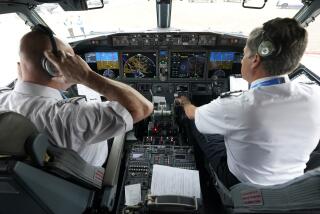Believe It or Not, Some Pilot ‘Cruise Snoozes’ Are a Safety Outlet
- Share via
Pilots for American Airlines recently made headlines by acknowledging that many of them occasionally take catnaps in the cockpit during flight. In an attempt to calm the public fear and outcry that could result from such adverse publicity, American’s management vehemently denied that any of their pilots doze on duty.
But who, I wonder, is best-informed about such matters, the pilots who do the dozing or those asleep behind their desks ignoring the gravity of this problem?
The truth is, American’s pilots are not the only ones to engage in cockpit catnapping. Having been an airline pilot for 34 years, I guarantee that it happens on every air carrier. It is time that someone begin a public dialogue about an industry problem that for too long has been swept under the carpet.
The industry needs to awaken to the realization that archaic duty regulations and a system of scheduling pilots by computer create situations that virtually guarantee flight crew fatigue. Much could be written about the wide variety of conditions and scenarios that lead to acute fatigue. But I doubt that there is an airline pilot alive who hasn’t at least propped his or her head with a hand to prevent it from nodding. It is a common cockpit ritual that takes place during the relative calm of cruise flight while the other pilot is at the helm, comforted by knowing that his turn will come.
I have seen a pilot so tired that he managed to hide his snoozing from a Federal Aviation Administration inspector in the jump seat. A snore almost gave the pilot away, but the inspector was asleep, too.
Such pilot snoozing obviously is illegal, but, done under controlled circumstances, it is far safer than forcing the eyes open with toothpicks or passing out during a landing approach. (I have twice observed this.)
This is why flight captains occasionally take the law into their own hands and rotate short catnaps in the cockpit. Besides, says one veteran pilot, “There’s nothing in the regulations that says we’re not allowed to faint.”
Another captain considers a nap as an extension of his emergency authority: “If my co-pilot is suffering from sleep deprivation, I’d rather have him take a ‘cruise snooze’ when there is little to do, because he’ll be refreshed when the workload increases.”
The publicity generated by the American pilots should serve as a wake-up call to the FAA and to airline management that pilots are not robots with payroll numbers. They are not necessarily rested simply because regulations and a scheduling computer say that they are and that they will remain so during their assignment, however long it may be.
The industry needs to recognize that naps under specific conditions would enhance safety, not erode it.
Some years ago, NASA conducted a study to determine how tired airline pilots become on international flights and what could be done to mitigate the problem. But a team of rocket scientists was not needed to learn that crews that fly international and “red-eye” flights are subject to acute fatigue and to conclude that catnaps in the cockpit should be approved (one pilot at a time, please).
Unfortunately, the NASA study did not go far enough. It failed to investigate domestic operations and how these crews can become equally or more fatigued. Consider the case of a TWA Boeing 727 crew heading for Los Angeles at sunrise after a lengthy and demanding duty period on the backside of the clock. The pilots failed to respond to their descent clearance from air traffic control because all three of them had fallen asleep. The pilots finally woke up but not until after the flight had passed serenely over Los Angeles and was 100 miles out to sea. All’s well that ends well, but obviously something was amiss here.
Earlier this year, it was revealed that both the captain and co-pilot in the cockpit of an MD-80 that crashed in Little Rock, Ark., were nearing their federally regulated maximum of about 14 hours. Investigation may or may not determine that the accident was connected to acute fatigue. But whatever is found in that case, it seems that it always takes an accident for the FAA to recognize problems that pilots face every day.
More to Read
Inside the business of entertainment
The Wide Shot brings you news, analysis and insights on everything from streaming wars to production — and what it all means for the future.
You may occasionally receive promotional content from the Los Angeles Times.










